Leadership, Management, and Operations: A Comparative Analysis
VerifiedAdded on 2023/01/12
|15
|5466
|75
Report
AI Summary
This report delves into the core concepts of leadership, management, and operations management, using a case study of a company and its new leader. It defines and compares the roles and characteristics of leaders and managers, highlighting their distinct functions within an organizational context. The report examines how these roles apply in various situational contexts, with examples of organizational change and product introductions. It explores different leadership theories and models, including situational, systems, and contingency approaches. Furthermore, the report analyzes key approaches to operations management and emphasizes its importance in achieving organizational goals, while also identifying factors that influence operational management and decision-making. The report provides a comprehensive overview of the interplay between leadership, management, and operational effectiveness, offering valuable insights for understanding and improving organizational performance.
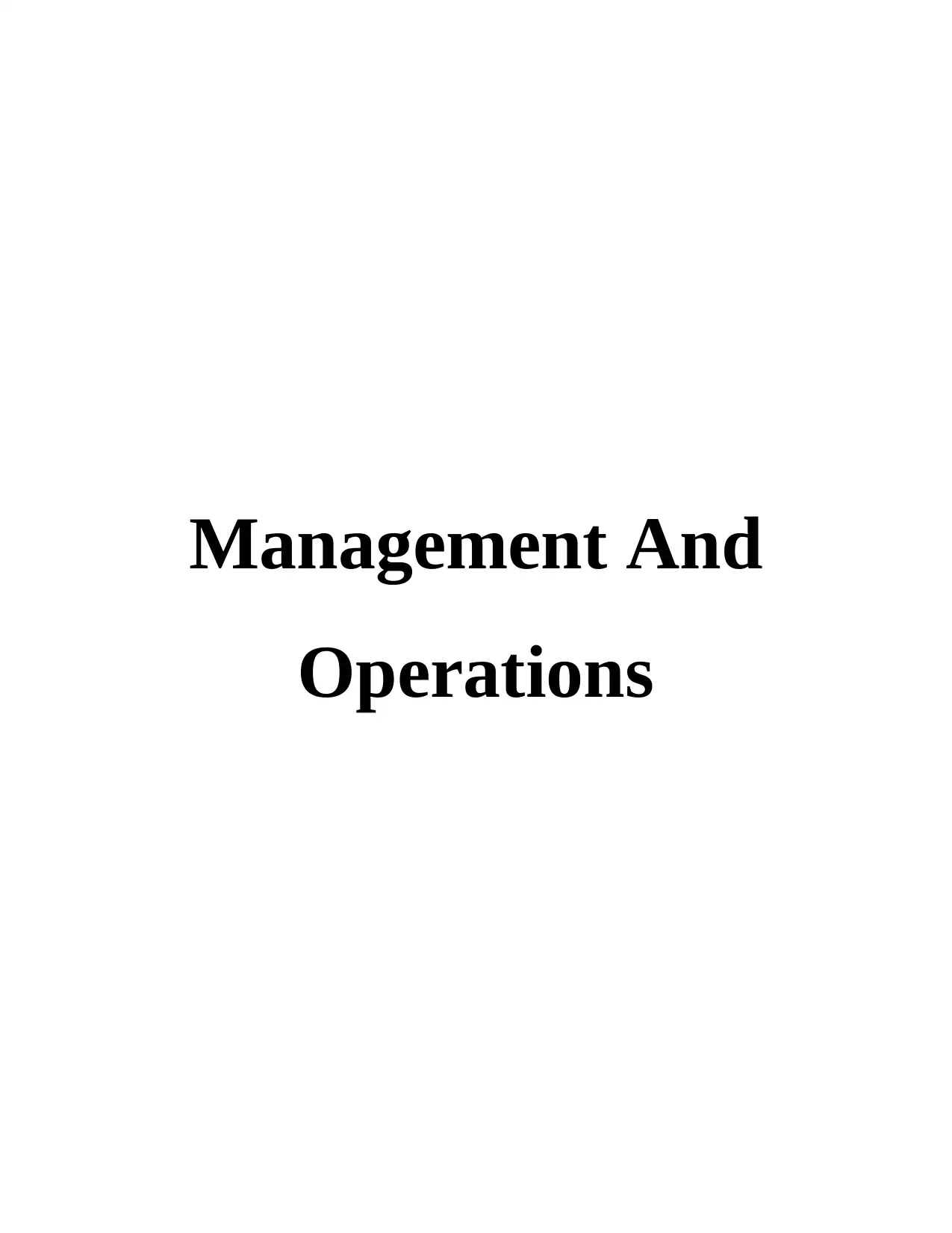
Management And
Operations
Operations
Paraphrase This Document
Need a fresh take? Get an instant paraphrase of this document with our AI Paraphraser
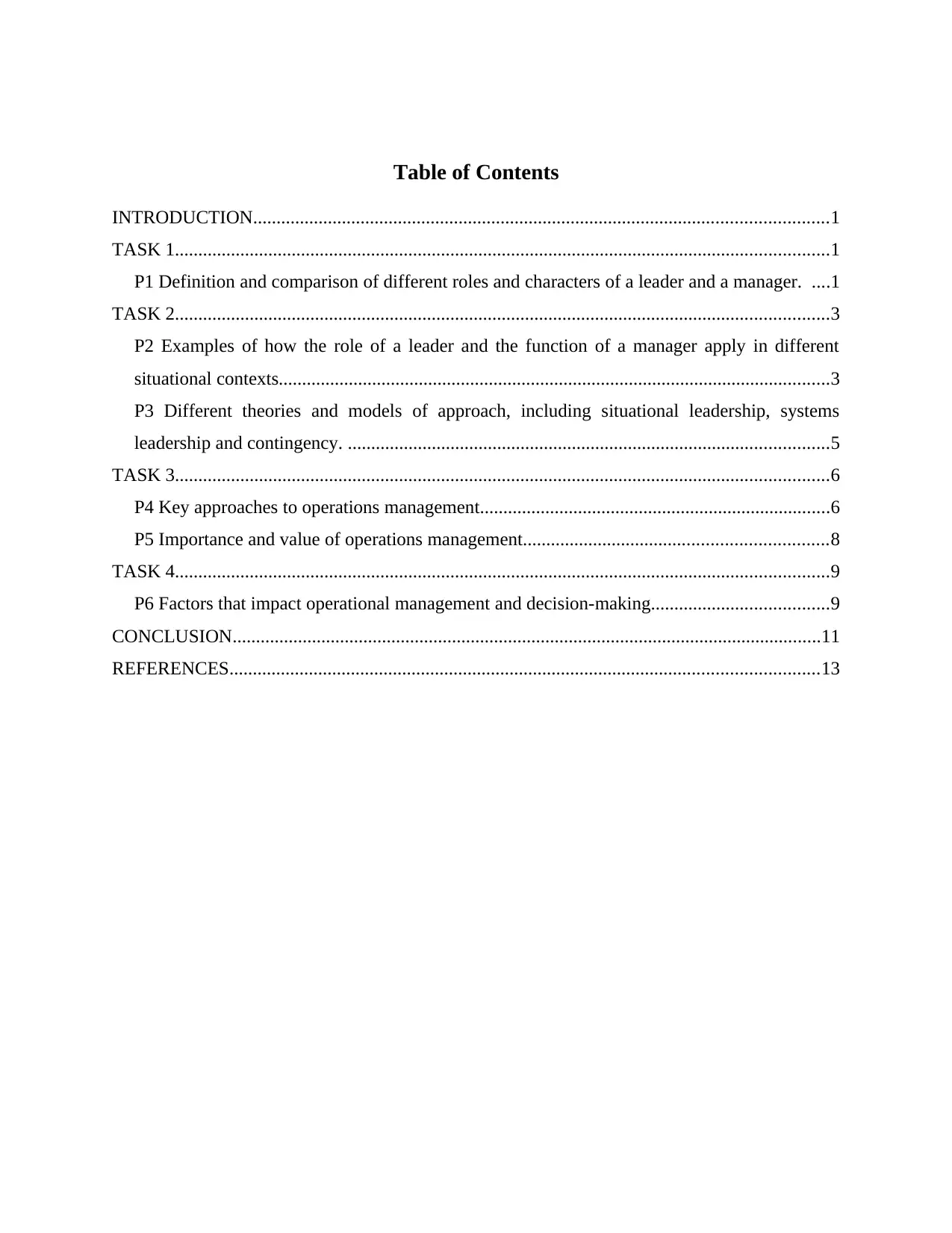
Table of Contents
INTRODUCTION...........................................................................................................................1
TASK 1............................................................................................................................................1
P1 Definition and comparison of different roles and characters of a leader and a manager. ....1
TASK 2............................................................................................................................................3
P2 Examples of how the role of a leader and the function of a manager apply in different
situational contexts......................................................................................................................3
P3 Different theories and models of approach, including situational leadership, systems
leadership and contingency. .......................................................................................................5
TASK 3............................................................................................................................................6
P4 Key approaches to operations management...........................................................................6
P5 Importance and value of operations management.................................................................8
TASK 4............................................................................................................................................9
P6 Factors that impact operational management and decision-making......................................9
CONCLUSION..............................................................................................................................11
REFERENCES..............................................................................................................................13
INTRODUCTION...........................................................................................................................1
TASK 1............................................................................................................................................1
P1 Definition and comparison of different roles and characters of a leader and a manager. ....1
TASK 2............................................................................................................................................3
P2 Examples of how the role of a leader and the function of a manager apply in different
situational contexts......................................................................................................................3
P3 Different theories and models of approach, including situational leadership, systems
leadership and contingency. .......................................................................................................5
TASK 3............................................................................................................................................6
P4 Key approaches to operations management...........................................................................6
P5 Importance and value of operations management.................................................................8
TASK 4............................................................................................................................................9
P6 Factors that impact operational management and decision-making......................................9
CONCLUSION..............................................................................................................................11
REFERENCES..............................................................................................................................13
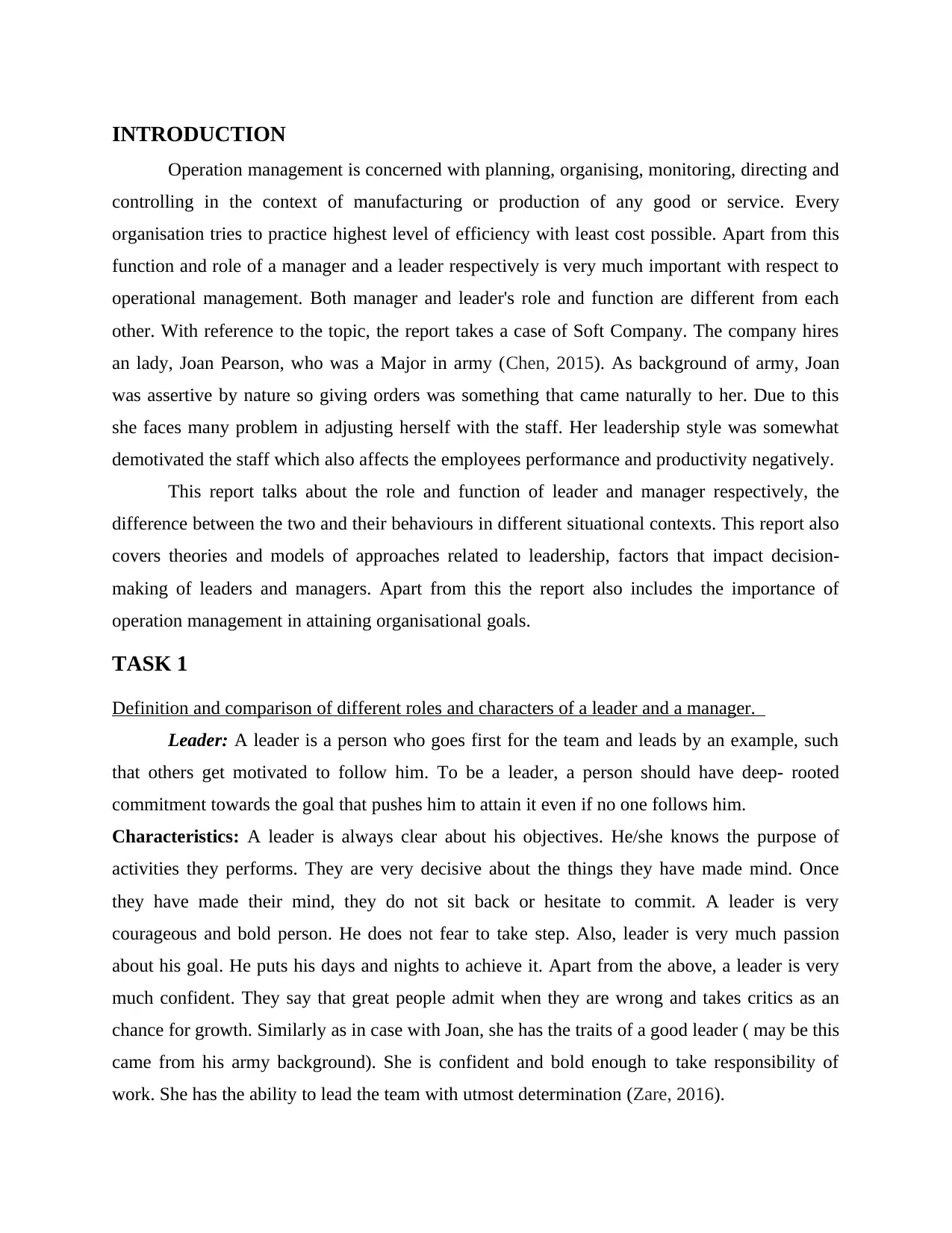
INTRODUCTION
Operation management is concerned with planning, organising, monitoring, directing and
controlling in the context of manufacturing or production of any good or service. Every
organisation tries to practice highest level of efficiency with least cost possible. Apart from this
function and role of a manager and a leader respectively is very much important with respect to
operational management. Both manager and leader's role and function are different from each
other. With reference to the topic, the report takes a case of Soft Company. The company hires
an lady, Joan Pearson, who was a Major in army (Chen, 2015). As background of army, Joan
was assertive by nature so giving orders was something that came naturally to her. Due to this
she faces many problem in adjusting herself with the staff. Her leadership style was somewhat
demotivated the staff which also affects the employees performance and productivity negatively.
This report talks about the role and function of leader and manager respectively, the
difference between the two and their behaviours in different situational contexts. This report also
covers theories and models of approaches related to leadership, factors that impact decision-
making of leaders and managers. Apart from this the report also includes the importance of
operation management in attaining organisational goals.
TASK 1
Definition and comparison of different roles and characters of a leader and a manager.
Leader: A leader is a person who goes first for the team and leads by an example, such
that others get motivated to follow him. To be a leader, a person should have deep- rooted
commitment towards the goal that pushes him to attain it even if no one follows him.
Characteristics: A leader is always clear about his objectives. He/she knows the purpose of
activities they performs. They are very decisive about the things they have made mind. Once
they have made their mind, they do not sit back or hesitate to commit. A leader is very
courageous and bold person. He does not fear to take step. Also, leader is very much passion
about his goal. He puts his days and nights to achieve it. Apart from the above, a leader is very
much confident. They say that great people admit when they are wrong and takes critics as an
chance for growth. Similarly as in case with Joan, she has the traits of a good leader ( may be this
came from his army background). She is confident and bold enough to take responsibility of
work. She has the ability to lead the team with utmost determination (Zare, 2016).
Operation management is concerned with planning, organising, monitoring, directing and
controlling in the context of manufacturing or production of any good or service. Every
organisation tries to practice highest level of efficiency with least cost possible. Apart from this
function and role of a manager and a leader respectively is very much important with respect to
operational management. Both manager and leader's role and function are different from each
other. With reference to the topic, the report takes a case of Soft Company. The company hires
an lady, Joan Pearson, who was a Major in army (Chen, 2015). As background of army, Joan
was assertive by nature so giving orders was something that came naturally to her. Due to this
she faces many problem in adjusting herself with the staff. Her leadership style was somewhat
demotivated the staff which also affects the employees performance and productivity negatively.
This report talks about the role and function of leader and manager respectively, the
difference between the two and their behaviours in different situational contexts. This report also
covers theories and models of approaches related to leadership, factors that impact decision-
making of leaders and managers. Apart from this the report also includes the importance of
operation management in attaining organisational goals.
TASK 1
Definition and comparison of different roles and characters of a leader and a manager.
Leader: A leader is a person who goes first for the team and leads by an example, such
that others get motivated to follow him. To be a leader, a person should have deep- rooted
commitment towards the goal that pushes him to attain it even if no one follows him.
Characteristics: A leader is always clear about his objectives. He/she knows the purpose of
activities they performs. They are very decisive about the things they have made mind. Once
they have made their mind, they do not sit back or hesitate to commit. A leader is very
courageous and bold person. He does not fear to take step. Also, leader is very much passion
about his goal. He puts his days and nights to achieve it. Apart from the above, a leader is very
much confident. They say that great people admit when they are wrong and takes critics as an
chance for growth. Similarly as in case with Joan, she has the traits of a good leader ( may be this
came from his army background). She is confident and bold enough to take responsibility of
work. She has the ability to lead the team with utmost determination (Zare, 2016).
⊘ This is a preview!⊘
Do you want full access?
Subscribe today to unlock all pages.

Trusted by 1+ million students worldwide
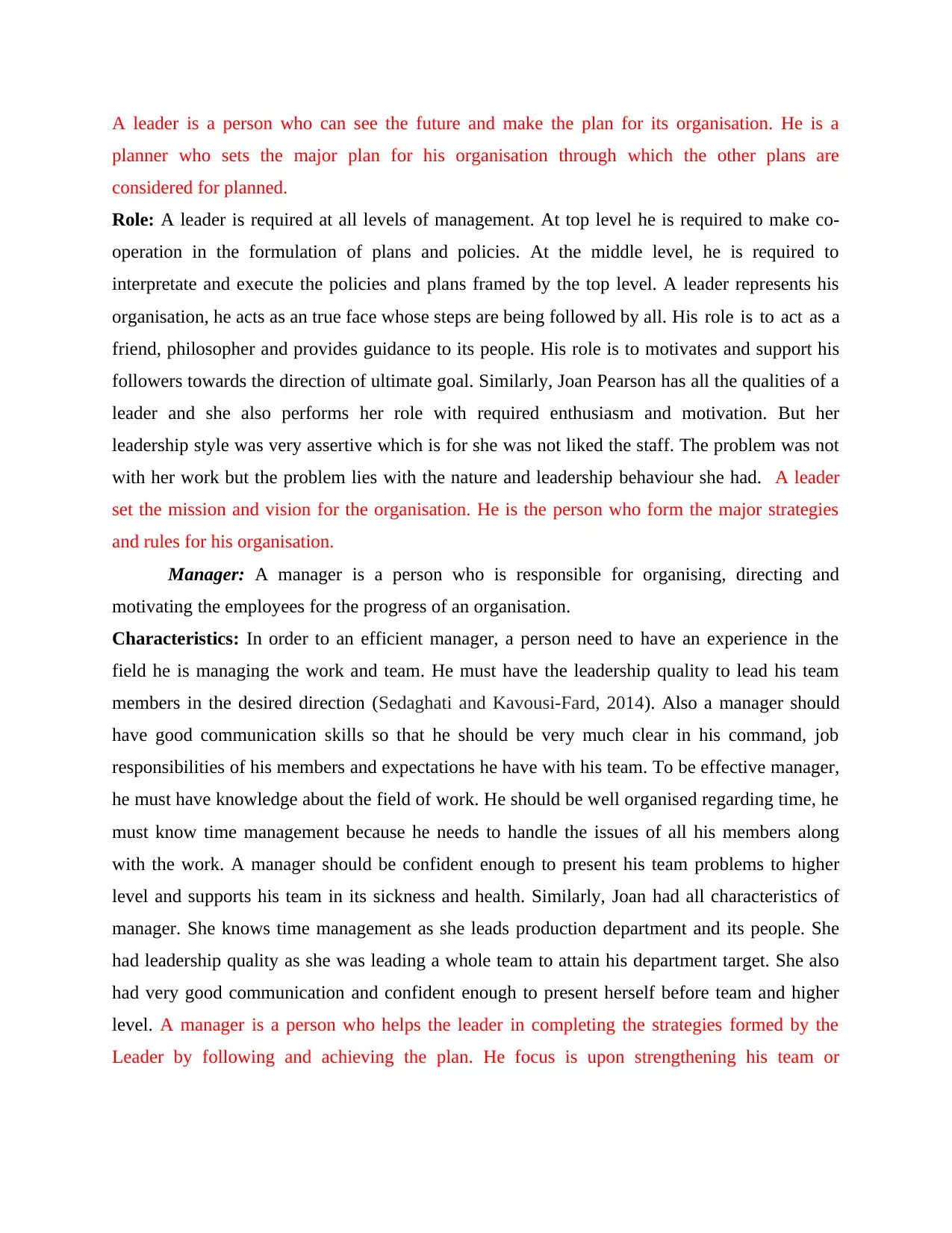
A leader is a person who can see the future and make the plan for its organisation. He is a
planner who sets the major plan for his organisation through which the other plans are
considered for planned.
Role: A leader is required at all levels of management. At top level he is required to make co-
operation in the formulation of plans and policies. At the middle level, he is required to
interpretate and execute the policies and plans framed by the top level. A leader represents his
organisation, he acts as an true face whose steps are being followed by all. His role is to act as a
friend, philosopher and provides guidance to its people. His role is to motivates and support his
followers towards the direction of ultimate goal. Similarly, Joan Pearson has all the qualities of a
leader and she also performs her role with required enthusiasm and motivation. But her
leadership style was very assertive which is for she was not liked the staff. The problem was not
with her work but the problem lies with the nature and leadership behaviour she had. A leader
set the mission and vision for the organisation. He is the person who form the major strategies
and rules for his organisation.
Manager: A manager is a person who is responsible for organising, directing and
motivating the employees for the progress of an organisation.
Characteristics: In order to an efficient manager, a person need to have an experience in the
field he is managing the work and team. He must have the leadership quality to lead his team
members in the desired direction (Sedaghati and Kavousi-Fard, 2014). Also a manager should
have good communication skills so that he should be very much clear in his command, job
responsibilities of his members and expectations he have with his team. To be effective manager,
he must have knowledge about the field of work. He should be well organised regarding time, he
must know time management because he needs to handle the issues of all his members along
with the work. A manager should be confident enough to present his team problems to higher
level and supports his team in its sickness and health. Similarly, Joan had all characteristics of
manager. She knows time management as she leads production department and its people. She
had leadership quality as she was leading a whole team to attain his department target. She also
had very good communication and confident enough to present herself before team and higher
level. A manager is a person who helps the leader in completing the strategies formed by the
Leader by following and achieving the plan. He focus is upon strengthening his team or
planner who sets the major plan for his organisation through which the other plans are
considered for planned.
Role: A leader is required at all levels of management. At top level he is required to make co-
operation in the formulation of plans and policies. At the middle level, he is required to
interpretate and execute the policies and plans framed by the top level. A leader represents his
organisation, he acts as an true face whose steps are being followed by all. His role is to act as a
friend, philosopher and provides guidance to its people. His role is to motivates and support his
followers towards the direction of ultimate goal. Similarly, Joan Pearson has all the qualities of a
leader and she also performs her role with required enthusiasm and motivation. But her
leadership style was very assertive which is for she was not liked the staff. The problem was not
with her work but the problem lies with the nature and leadership behaviour she had. A leader
set the mission and vision for the organisation. He is the person who form the major strategies
and rules for his organisation.
Manager: A manager is a person who is responsible for organising, directing and
motivating the employees for the progress of an organisation.
Characteristics: In order to an efficient manager, a person need to have an experience in the
field he is managing the work and team. He must have the leadership quality to lead his team
members in the desired direction (Sedaghati and Kavousi-Fard, 2014). Also a manager should
have good communication skills so that he should be very much clear in his command, job
responsibilities of his members and expectations he have with his team. To be effective manager,
he must have knowledge about the field of work. He should be well organised regarding time, he
must know time management because he needs to handle the issues of all his members along
with the work. A manager should be confident enough to present his team problems to higher
level and supports his team in its sickness and health. Similarly, Joan had all characteristics of
manager. She knows time management as she leads production department and its people. She
had leadership quality as she was leading a whole team to attain his department target. She also
had very good communication and confident enough to present herself before team and higher
level. A manager is a person who helps the leader in completing the strategies formed by the
Leader by following and achieving the plan. He focus is upon strengthening his team or
Paraphrase This Document
Need a fresh take? Get an instant paraphrase of this document with our AI Paraphraser
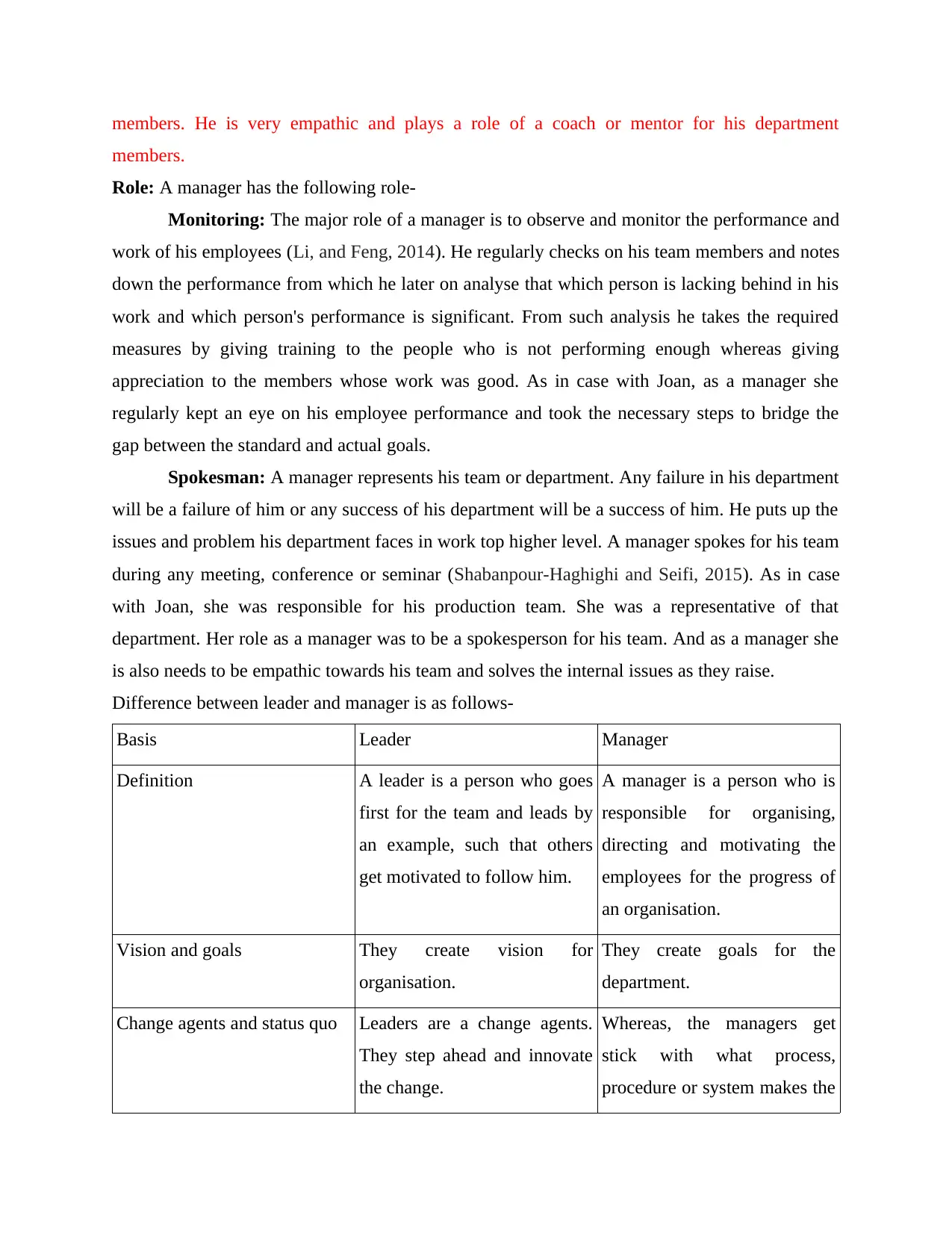
members. He is very empathic and plays a role of a coach or mentor for his department
members.
Role: A manager has the following role-
Monitoring: The major role of a manager is to observe and monitor the performance and
work of his employees (Li, and Feng, 2014). He regularly checks on his team members and notes
down the performance from which he later on analyse that which person is lacking behind in his
work and which person's performance is significant. From such analysis he takes the required
measures by giving training to the people who is not performing enough whereas giving
appreciation to the members whose work was good. As in case with Joan, as a manager she
regularly kept an eye on his employee performance and took the necessary steps to bridge the
gap between the standard and actual goals.
Spokesman: A manager represents his team or department. Any failure in his department
will be a failure of him or any success of his department will be a success of him. He puts up the
issues and problem his department faces in work top higher level. A manager spokes for his team
during any meeting, conference or seminar (Shabanpour-Haghighi and Seifi, 2015). As in case
with Joan, she was responsible for his production team. She was a representative of that
department. Her role as a manager was to be a spokesperson for his team. And as a manager she
is also needs to be empathic towards his team and solves the internal issues as they raise.
Difference between leader and manager is as follows-
Basis Leader Manager
Definition A leader is a person who goes
first for the team and leads by
an example, such that others
get motivated to follow him.
A manager is a person who is
responsible for organising,
directing and motivating the
employees for the progress of
an organisation.
Vision and goals They create vision for
organisation.
They create goals for the
department.
Change agents and status quo Leaders are a change agents.
They step ahead and innovate
the change.
Whereas, the managers get
stick with what process,
procedure or system makes the
members.
Role: A manager has the following role-
Monitoring: The major role of a manager is to observe and monitor the performance and
work of his employees (Li, and Feng, 2014). He regularly checks on his team members and notes
down the performance from which he later on analyse that which person is lacking behind in his
work and which person's performance is significant. From such analysis he takes the required
measures by giving training to the people who is not performing enough whereas giving
appreciation to the members whose work was good. As in case with Joan, as a manager she
regularly kept an eye on his employee performance and took the necessary steps to bridge the
gap between the standard and actual goals.
Spokesman: A manager represents his team or department. Any failure in his department
will be a failure of him or any success of his department will be a success of him. He puts up the
issues and problem his department faces in work top higher level. A manager spokes for his team
during any meeting, conference or seminar (Shabanpour-Haghighi and Seifi, 2015). As in case
with Joan, she was responsible for his production team. She was a representative of that
department. Her role as a manager was to be a spokesperson for his team. And as a manager she
is also needs to be empathic towards his team and solves the internal issues as they raise.
Difference between leader and manager is as follows-
Basis Leader Manager
Definition A leader is a person who goes
first for the team and leads by
an example, such that others
get motivated to follow him.
A manager is a person who is
responsible for organising,
directing and motivating the
employees for the progress of
an organisation.
Vision and goals They create vision for
organisation.
They create goals for the
department.
Change agents and status quo Leaders are a change agents.
They step ahead and innovate
the change.
Whereas, the managers get
stick with what process,
procedure or system makes the
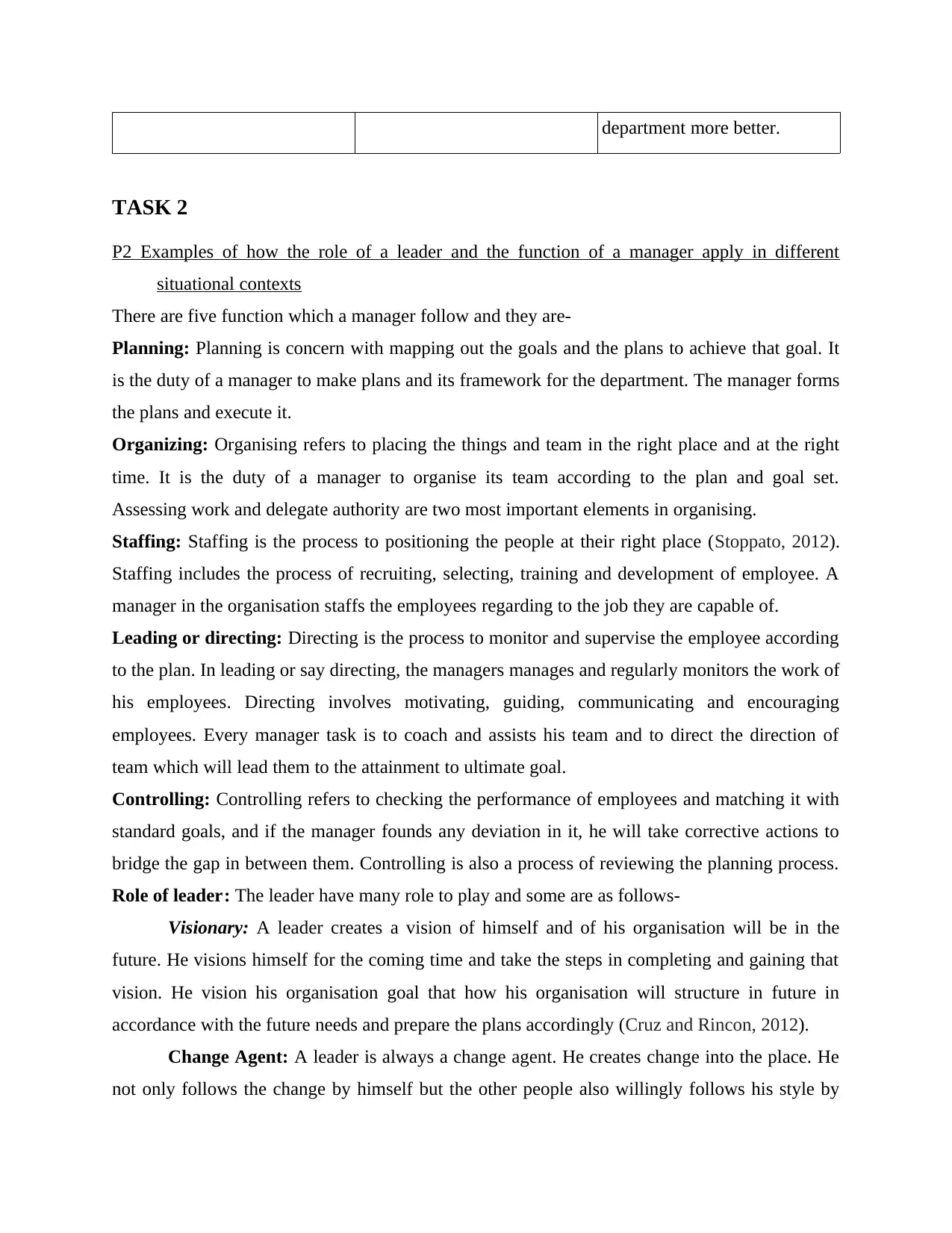
department more better.
TASK 2
P2 Examples of how the role of a leader and the function of a manager apply in different
situational contexts
There are five function which a manager follow and they are-
Planning: Planning is concern with mapping out the goals and the plans to achieve that goal. It
is the duty of a manager to make plans and its framework for the department. The manager forms
the plans and execute it.
Organizing: Organising refers to placing the things and team in the right place and at the right
time. It is the duty of a manager to organise its team according to the plan and goal set.
Assessing work and delegate authority are two most important elements in organising.
Staffing: Staffing is the process to positioning the people at their right place (Stoppato, 2012).
Staffing includes the process of recruiting, selecting, training and development of employee. A
manager in the organisation staffs the employees regarding to the job they are capable of.
Leading or directing: Directing is the process to monitor and supervise the employee according
to the plan. In leading or say directing, the managers manages and regularly monitors the work of
his employees. Directing involves motivating, guiding, communicating and encouraging
employees. Every manager task is to coach and assists his team and to direct the direction of
team which will lead them to the attainment to ultimate goal.
Controlling: Controlling refers to checking the performance of employees and matching it with
standard goals, and if the manager founds any deviation in it, he will take corrective actions to
bridge the gap in between them. Controlling is also a process of reviewing the planning process.
Role of leader: The leader have many role to play and some are as follows-
Visionary: A leader creates a vision of himself and of his organisation will be in the
future. He visions himself for the coming time and take the steps in completing and gaining that
vision. He vision his organisation goal that how his organisation will structure in future in
accordance with the future needs and prepare the plans accordingly (Cruz and Rincon, 2012).
Change Agent: A leader is always a change agent. He creates change into the place. He
not only follows the change by himself but the other people also willingly follows his style by
TASK 2
P2 Examples of how the role of a leader and the function of a manager apply in different
situational contexts
There are five function which a manager follow and they are-
Planning: Planning is concern with mapping out the goals and the plans to achieve that goal. It
is the duty of a manager to make plans and its framework for the department. The manager forms
the plans and execute it.
Organizing: Organising refers to placing the things and team in the right place and at the right
time. It is the duty of a manager to organise its team according to the plan and goal set.
Assessing work and delegate authority are two most important elements in organising.
Staffing: Staffing is the process to positioning the people at their right place (Stoppato, 2012).
Staffing includes the process of recruiting, selecting, training and development of employee. A
manager in the organisation staffs the employees regarding to the job they are capable of.
Leading or directing: Directing is the process to monitor and supervise the employee according
to the plan. In leading or say directing, the managers manages and regularly monitors the work of
his employees. Directing involves motivating, guiding, communicating and encouraging
employees. Every manager task is to coach and assists his team and to direct the direction of
team which will lead them to the attainment to ultimate goal.
Controlling: Controlling refers to checking the performance of employees and matching it with
standard goals, and if the manager founds any deviation in it, he will take corrective actions to
bridge the gap in between them. Controlling is also a process of reviewing the planning process.
Role of leader: The leader have many role to play and some are as follows-
Visionary: A leader creates a vision of himself and of his organisation will be in the
future. He visions himself for the coming time and take the steps in completing and gaining that
vision. He vision his organisation goal that how his organisation will structure in future in
accordance with the future needs and prepare the plans accordingly (Cruz and Rincon, 2012).
Change Agent: A leader is always a change agent. He creates change into the place. He
not only follows the change by himself but the other people also willingly follows his style by
⊘ This is a preview!⊘
Do you want full access?
Subscribe today to unlock all pages.

Trusted by 1+ million students worldwide
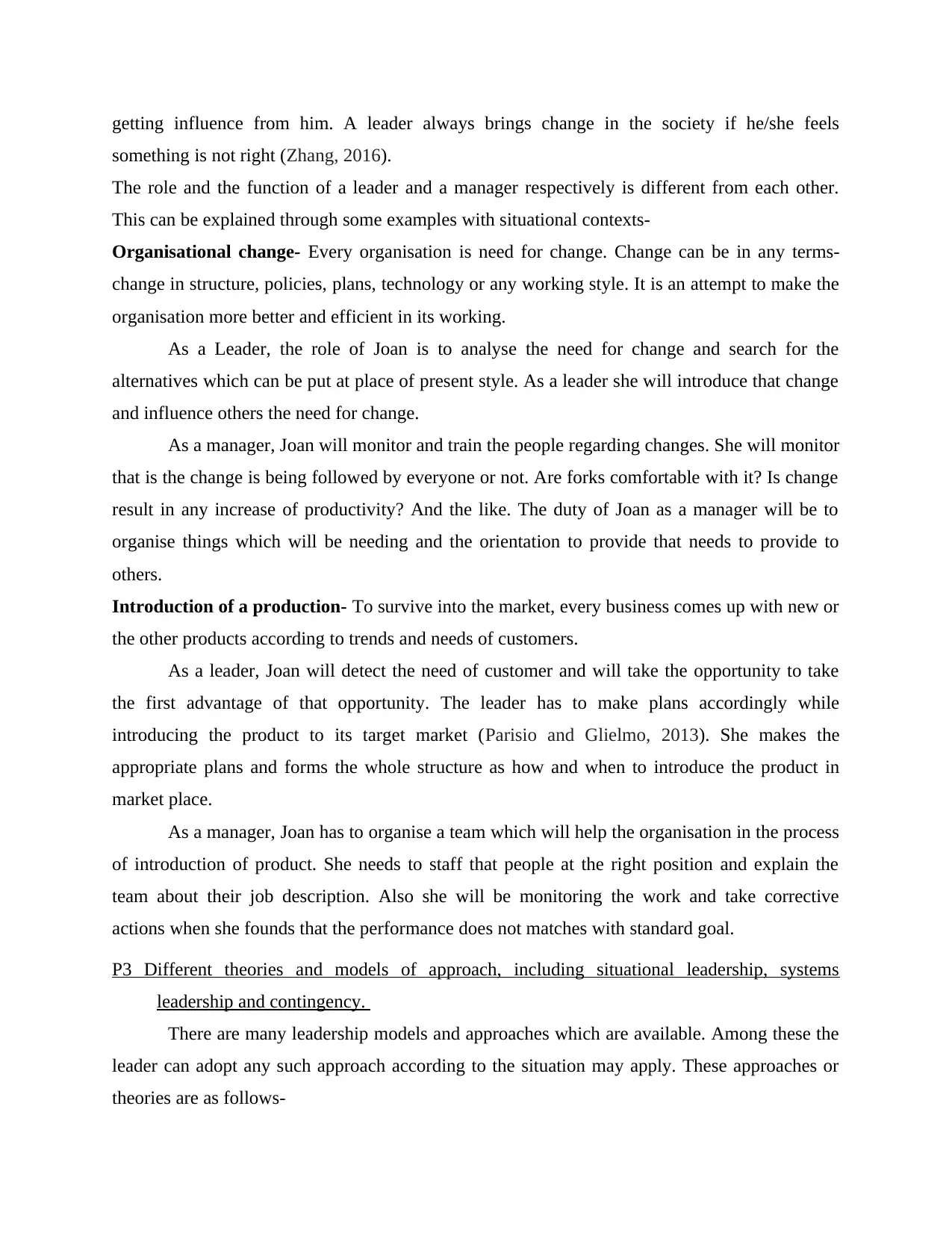
getting influence from him. A leader always brings change in the society if he/she feels
something is not right (Zhang, 2016).
The role and the function of a leader and a manager respectively is different from each other.
This can be explained through some examples with situational contexts-
Organisational change- Every organisation is need for change. Change can be in any terms-
change in structure, policies, plans, technology or any working style. It is an attempt to make the
organisation more better and efficient in its working.
As a Leader, the role of Joan is to analyse the need for change and search for the
alternatives which can be put at place of present style. As a leader she will introduce that change
and influence others the need for change.
As a manager, Joan will monitor and train the people regarding changes. She will monitor
that is the change is being followed by everyone or not. Are forks comfortable with it? Is change
result in any increase of productivity? And the like. The duty of Joan as a manager will be to
organise things which will be needing and the orientation to provide that needs to provide to
others.
Introduction of a production- To survive into the market, every business comes up with new or
the other products according to trends and needs of customers.
As a leader, Joan will detect the need of customer and will take the opportunity to take
the first advantage of that opportunity. The leader has to make plans accordingly while
introducing the product to its target market (Parisio and Glielmo, 2013). She makes the
appropriate plans and forms the whole structure as how and when to introduce the product in
market place.
As a manager, Joan has to organise a team which will help the organisation in the process
of introduction of product. She needs to staff that people at the right position and explain the
team about their job description. Also she will be monitoring the work and take corrective
actions when she founds that the performance does not matches with standard goal.
P3 Different theories and models of approach, including situational leadership, systems
leadership and contingency.
There are many leadership models and approaches which are available. Among these the
leader can adopt any such approach according to the situation may apply. These approaches or
theories are as follows-
something is not right (Zhang, 2016).
The role and the function of a leader and a manager respectively is different from each other.
This can be explained through some examples with situational contexts-
Organisational change- Every organisation is need for change. Change can be in any terms-
change in structure, policies, plans, technology or any working style. It is an attempt to make the
organisation more better and efficient in its working.
As a Leader, the role of Joan is to analyse the need for change and search for the
alternatives which can be put at place of present style. As a leader she will introduce that change
and influence others the need for change.
As a manager, Joan will monitor and train the people regarding changes. She will monitor
that is the change is being followed by everyone or not. Are forks comfortable with it? Is change
result in any increase of productivity? And the like. The duty of Joan as a manager will be to
organise things which will be needing and the orientation to provide that needs to provide to
others.
Introduction of a production- To survive into the market, every business comes up with new or
the other products according to trends and needs of customers.
As a leader, Joan will detect the need of customer and will take the opportunity to take
the first advantage of that opportunity. The leader has to make plans accordingly while
introducing the product to its target market (Parisio and Glielmo, 2013). She makes the
appropriate plans and forms the whole structure as how and when to introduce the product in
market place.
As a manager, Joan has to organise a team which will help the organisation in the process
of introduction of product. She needs to staff that people at the right position and explain the
team about their job description. Also she will be monitoring the work and take corrective
actions when she founds that the performance does not matches with standard goal.
P3 Different theories and models of approach, including situational leadership, systems
leadership and contingency.
There are many leadership models and approaches which are available. Among these the
leader can adopt any such approach according to the situation may apply. These approaches or
theories are as follows-
Paraphrase This Document
Need a fresh take? Get an instant paraphrase of this document with our AI Paraphraser
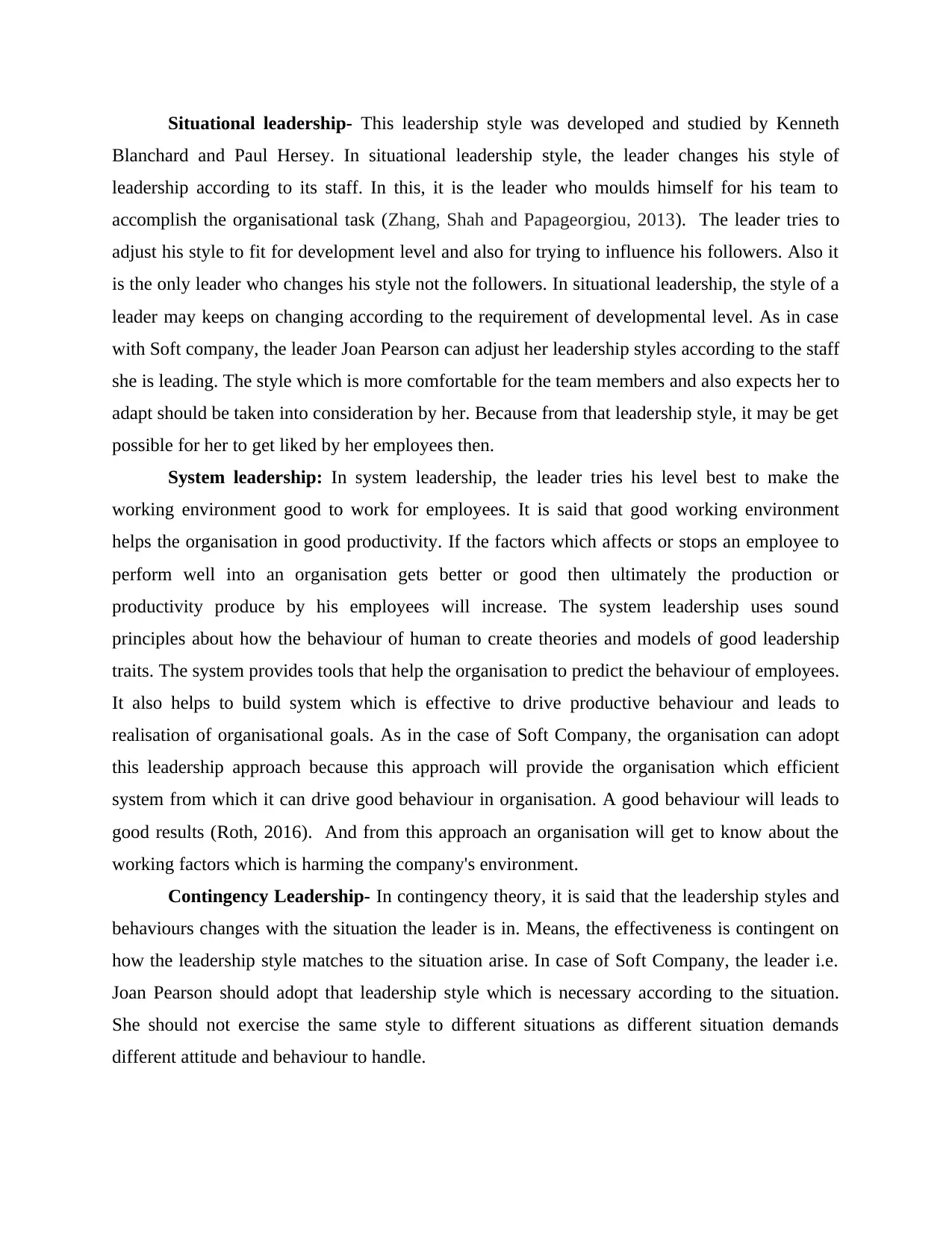
Situational leadership- This leadership style was developed and studied by Kenneth
Blanchard and Paul Hersey. In situational leadership style, the leader changes his style of
leadership according to its staff. In this, it is the leader who moulds himself for his team to
accomplish the organisational task (Zhang, Shah and Papageorgiou, 2013). The leader tries to
adjust his style to fit for development level and also for trying to influence his followers. Also it
is the only leader who changes his style not the followers. In situational leadership, the style of a
leader may keeps on changing according to the requirement of developmental level. As in case
with Soft company, the leader Joan Pearson can adjust her leadership styles according to the staff
she is leading. The style which is more comfortable for the team members and also expects her to
adapt should be taken into consideration by her. Because from that leadership style, it may be get
possible for her to get liked by her employees then.
System leadership: In system leadership, the leader tries his level best to make the
working environment good to work for employees. It is said that good working environment
helps the organisation in good productivity. If the factors which affects or stops an employee to
perform well into an organisation gets better or good then ultimately the production or
productivity produce by his employees will increase. The system leadership uses sound
principles about how the behaviour of human to create theories and models of good leadership
traits. The system provides tools that help the organisation to predict the behaviour of employees.
It also helps to build system which is effective to drive productive behaviour and leads to
realisation of organisational goals. As in the case of Soft Company, the organisation can adopt
this leadership approach because this approach will provide the organisation which efficient
system from which it can drive good behaviour in organisation. A good behaviour will leads to
good results (Roth, 2016). And from this approach an organisation will get to know about the
working factors which is harming the company's environment.
Contingency Leadership- In contingency theory, it is said that the leadership styles and
behaviours changes with the situation the leader is in. Means, the effectiveness is contingent on
how the leadership style matches to the situation arise. In case of Soft Company, the leader i.e.
Joan Pearson should adopt that leadership style which is necessary according to the situation.
She should not exercise the same style to different situations as different situation demands
different attitude and behaviour to handle.
Blanchard and Paul Hersey. In situational leadership style, the leader changes his style of
leadership according to its staff. In this, it is the leader who moulds himself for his team to
accomplish the organisational task (Zhang, Shah and Papageorgiou, 2013). The leader tries to
adjust his style to fit for development level and also for trying to influence his followers. Also it
is the only leader who changes his style not the followers. In situational leadership, the style of a
leader may keeps on changing according to the requirement of developmental level. As in case
with Soft company, the leader Joan Pearson can adjust her leadership styles according to the staff
she is leading. The style which is more comfortable for the team members and also expects her to
adapt should be taken into consideration by her. Because from that leadership style, it may be get
possible for her to get liked by her employees then.
System leadership: In system leadership, the leader tries his level best to make the
working environment good to work for employees. It is said that good working environment
helps the organisation in good productivity. If the factors which affects or stops an employee to
perform well into an organisation gets better or good then ultimately the production or
productivity produce by his employees will increase. The system leadership uses sound
principles about how the behaviour of human to create theories and models of good leadership
traits. The system provides tools that help the organisation to predict the behaviour of employees.
It also helps to build system which is effective to drive productive behaviour and leads to
realisation of organisational goals. As in the case of Soft Company, the organisation can adopt
this leadership approach because this approach will provide the organisation which efficient
system from which it can drive good behaviour in organisation. A good behaviour will leads to
good results (Roth, 2016). And from this approach an organisation will get to know about the
working factors which is harming the company's environment.
Contingency Leadership- In contingency theory, it is said that the leadership styles and
behaviours changes with the situation the leader is in. Means, the effectiveness is contingent on
how the leadership style matches to the situation arise. In case of Soft Company, the leader i.e.
Joan Pearson should adopt that leadership style which is necessary according to the situation.
She should not exercise the same style to different situations as different situation demands
different attitude and behaviour to handle.
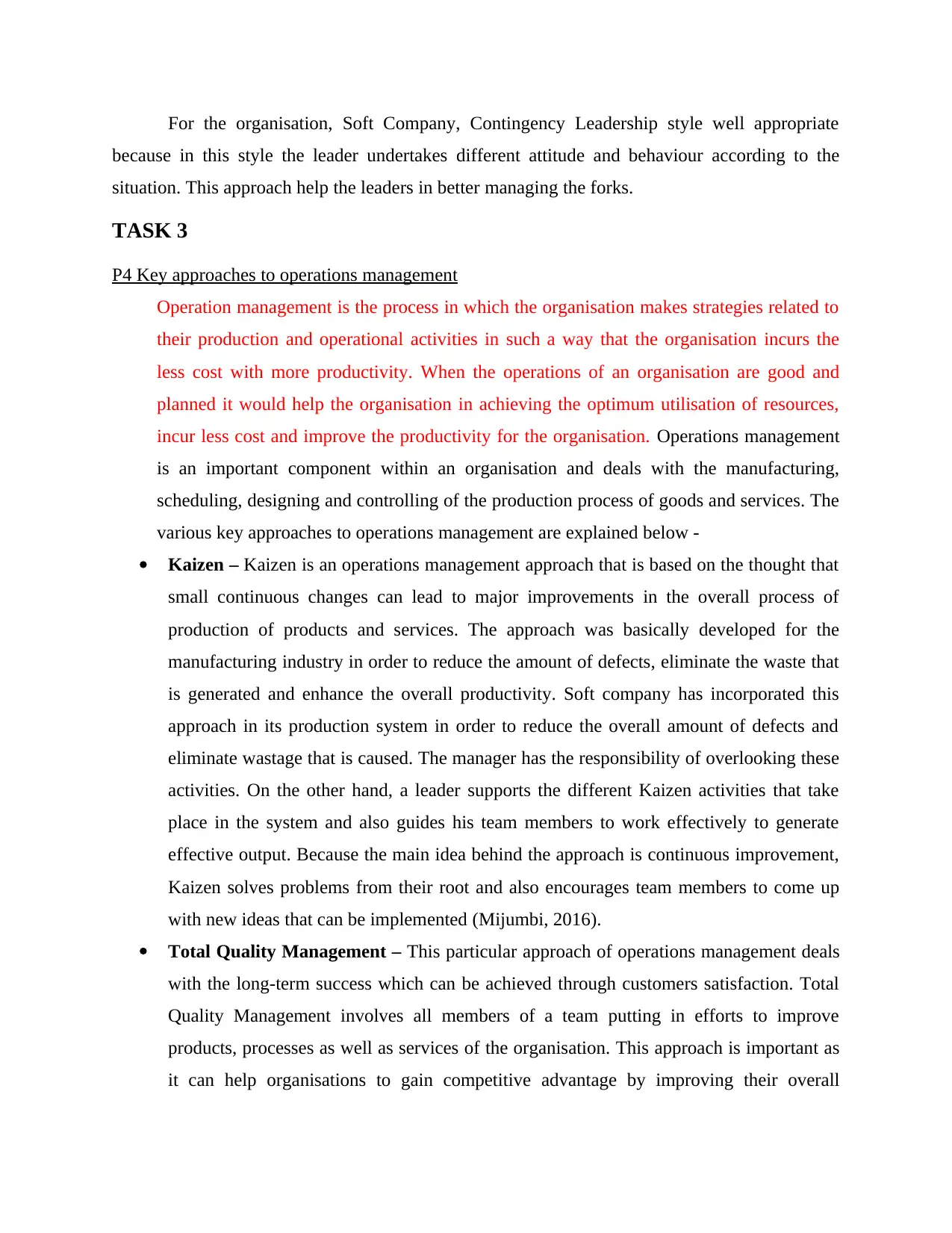
For the organisation, Soft Company, Contingency Leadership style well appropriate
because in this style the leader undertakes different attitude and behaviour according to the
situation. This approach help the leaders in better managing the forks.
TASK 3
P4 Key approaches to operations management
Operation management is the process in which the organisation makes strategies related to
their production and operational activities in such a way that the organisation incurs the
less cost with more productivity. When the operations of an organisation are good and
planned it would help the organisation in achieving the optimum utilisation of resources,
incur less cost and improve the productivity for the organisation. Operations management
is an important component within an organisation and deals with the manufacturing,
scheduling, designing and controlling of the production process of goods and services. The
various key approaches to operations management are explained below -
Kaizen – Kaizen is an operations management approach that is based on the thought that
small continuous changes can lead to major improvements in the overall process of
production of products and services. The approach was basically developed for the
manufacturing industry in order to reduce the amount of defects, eliminate the waste that
is generated and enhance the overall productivity. Soft company has incorporated this
approach in its production system in order to reduce the overall amount of defects and
eliminate wastage that is caused. The manager has the responsibility of overlooking these
activities. On the other hand, a leader supports the different Kaizen activities that take
place in the system and also guides his team members to work effectively to generate
effective output. Because the main idea behind the approach is continuous improvement,
Kaizen solves problems from their root and also encourages team members to come up
with new ideas that can be implemented (Mijumbi, 2016).
Total Quality Management – This particular approach of operations management deals
with the long-term success which can be achieved through customers satisfaction. Total
Quality Management involves all members of a team putting in efforts to improve
products, processes as well as services of the organisation. This approach is important as
it can help organisations to gain competitive advantage by improving their overall
because in this style the leader undertakes different attitude and behaviour according to the
situation. This approach help the leaders in better managing the forks.
TASK 3
P4 Key approaches to operations management
Operation management is the process in which the organisation makes strategies related to
their production and operational activities in such a way that the organisation incurs the
less cost with more productivity. When the operations of an organisation are good and
planned it would help the organisation in achieving the optimum utilisation of resources,
incur less cost and improve the productivity for the organisation. Operations management
is an important component within an organisation and deals with the manufacturing,
scheduling, designing and controlling of the production process of goods and services. The
various key approaches to operations management are explained below -
Kaizen – Kaizen is an operations management approach that is based on the thought that
small continuous changes can lead to major improvements in the overall process of
production of products and services. The approach was basically developed for the
manufacturing industry in order to reduce the amount of defects, eliminate the waste that
is generated and enhance the overall productivity. Soft company has incorporated this
approach in its production system in order to reduce the overall amount of defects and
eliminate wastage that is caused. The manager has the responsibility of overlooking these
activities. On the other hand, a leader supports the different Kaizen activities that take
place in the system and also guides his team members to work effectively to generate
effective output. Because the main idea behind the approach is continuous improvement,
Kaizen solves problems from their root and also encourages team members to come up
with new ideas that can be implemented (Mijumbi, 2016).
Total Quality Management – This particular approach of operations management deals
with the long-term success which can be achieved through customers satisfaction. Total
Quality Management involves all members of a team putting in efforts to improve
products, processes as well as services of the organisation. This approach is important as
it can help organisations to gain competitive advantage by improving their overall
⊘ This is a preview!⊘
Do you want full access?
Subscribe today to unlock all pages.

Trusted by 1+ million students worldwide
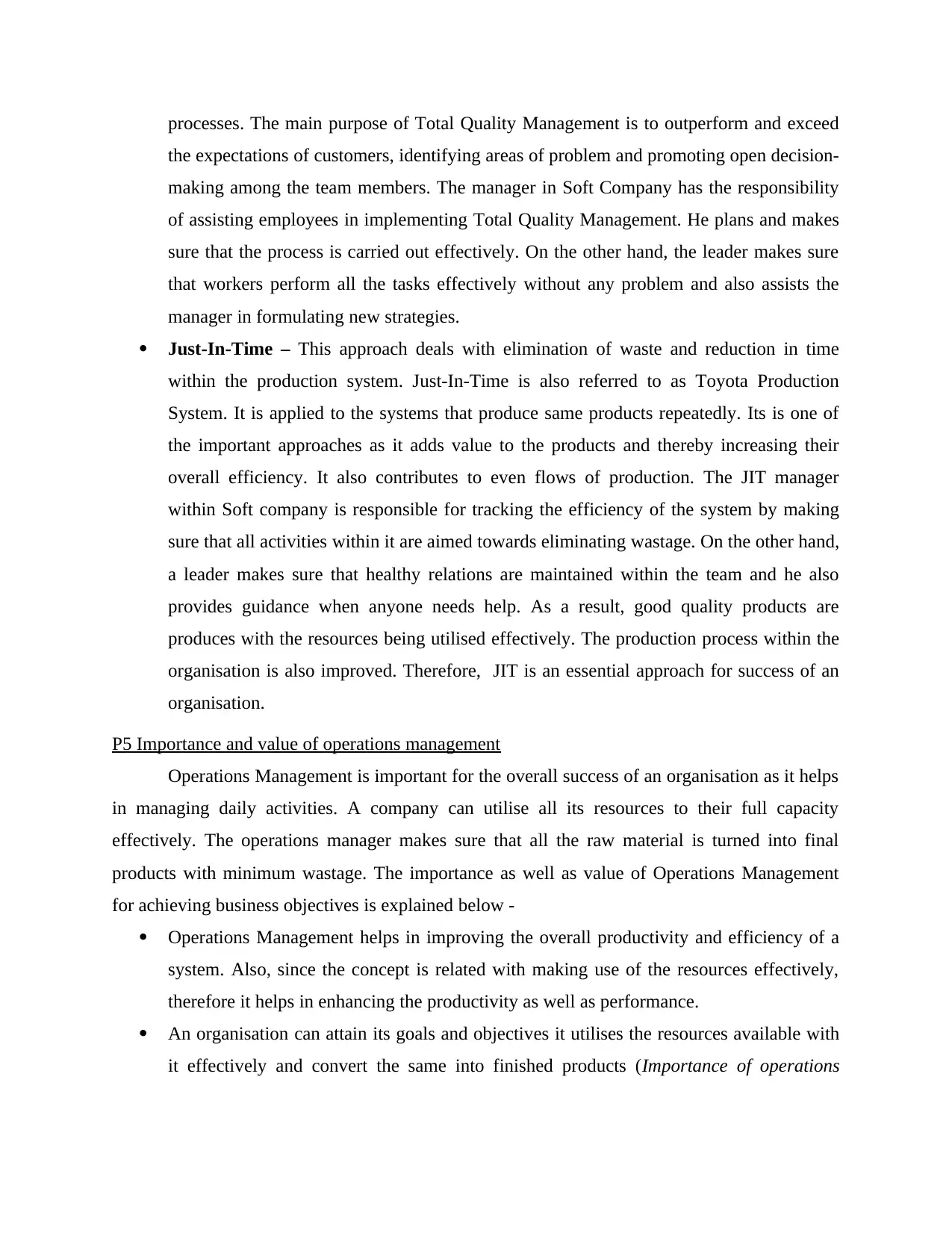
processes. The main purpose of Total Quality Management is to outperform and exceed
the expectations of customers, identifying areas of problem and promoting open decision-
making among the team members. The manager in Soft Company has the responsibility
of assisting employees in implementing Total Quality Management. He plans and makes
sure that the process is carried out effectively. On the other hand, the leader makes sure
that workers perform all the tasks effectively without any problem and also assists the
manager in formulating new strategies.
Just-In-Time – This approach deals with elimination of waste and reduction in time
within the production system. Just-In-Time is also referred to as Toyota Production
System. It is applied to the systems that produce same products repeatedly. Its is one of
the important approaches as it adds value to the products and thereby increasing their
overall efficiency. It also contributes to even flows of production. The JIT manager
within Soft company is responsible for tracking the efficiency of the system by making
sure that all activities within it are aimed towards eliminating wastage. On the other hand,
a leader makes sure that healthy relations are maintained within the team and he also
provides guidance when anyone needs help. As a result, good quality products are
produces with the resources being utilised effectively. The production process within the
organisation is also improved. Therefore, JIT is an essential approach for success of an
organisation.
P5 Importance and value of operations management
Operations Management is important for the overall success of an organisation as it helps
in managing daily activities. A company can utilise all its resources to their full capacity
effectively. The operations manager makes sure that all the raw material is turned into final
products with minimum wastage. The importance as well as value of Operations Management
for achieving business objectives is explained below -
Operations Management helps in improving the overall productivity and efficiency of a
system. Also, since the concept is related with making use of the resources effectively,
therefore it helps in enhancing the productivity as well as performance.
An organisation can attain its goals and objectives it utilises the resources available with
it effectively and convert the same into finished products (Importance of operations
the expectations of customers, identifying areas of problem and promoting open decision-
making among the team members. The manager in Soft Company has the responsibility
of assisting employees in implementing Total Quality Management. He plans and makes
sure that the process is carried out effectively. On the other hand, the leader makes sure
that workers perform all the tasks effectively without any problem and also assists the
manager in formulating new strategies.
Just-In-Time – This approach deals with elimination of waste and reduction in time
within the production system. Just-In-Time is also referred to as Toyota Production
System. It is applied to the systems that produce same products repeatedly. Its is one of
the important approaches as it adds value to the products and thereby increasing their
overall efficiency. It also contributes to even flows of production. The JIT manager
within Soft company is responsible for tracking the efficiency of the system by making
sure that all activities within it are aimed towards eliminating wastage. On the other hand,
a leader makes sure that healthy relations are maintained within the team and he also
provides guidance when anyone needs help. As a result, good quality products are
produces with the resources being utilised effectively. The production process within the
organisation is also improved. Therefore, JIT is an essential approach for success of an
organisation.
P5 Importance and value of operations management
Operations Management is important for the overall success of an organisation as it helps
in managing daily activities. A company can utilise all its resources to their full capacity
effectively. The operations manager makes sure that all the raw material is turned into final
products with minimum wastage. The importance as well as value of Operations Management
for achieving business objectives is explained below -
Operations Management helps in improving the overall productivity and efficiency of a
system. Also, since the concept is related with making use of the resources effectively,
therefore it helps in enhancing the productivity as well as performance.
An organisation can attain its goals and objectives it utilises the resources available with
it effectively and convert the same into finished products (Importance of operations
Paraphrase This Document
Need a fresh take? Get an instant paraphrase of this document with our AI Paraphraser
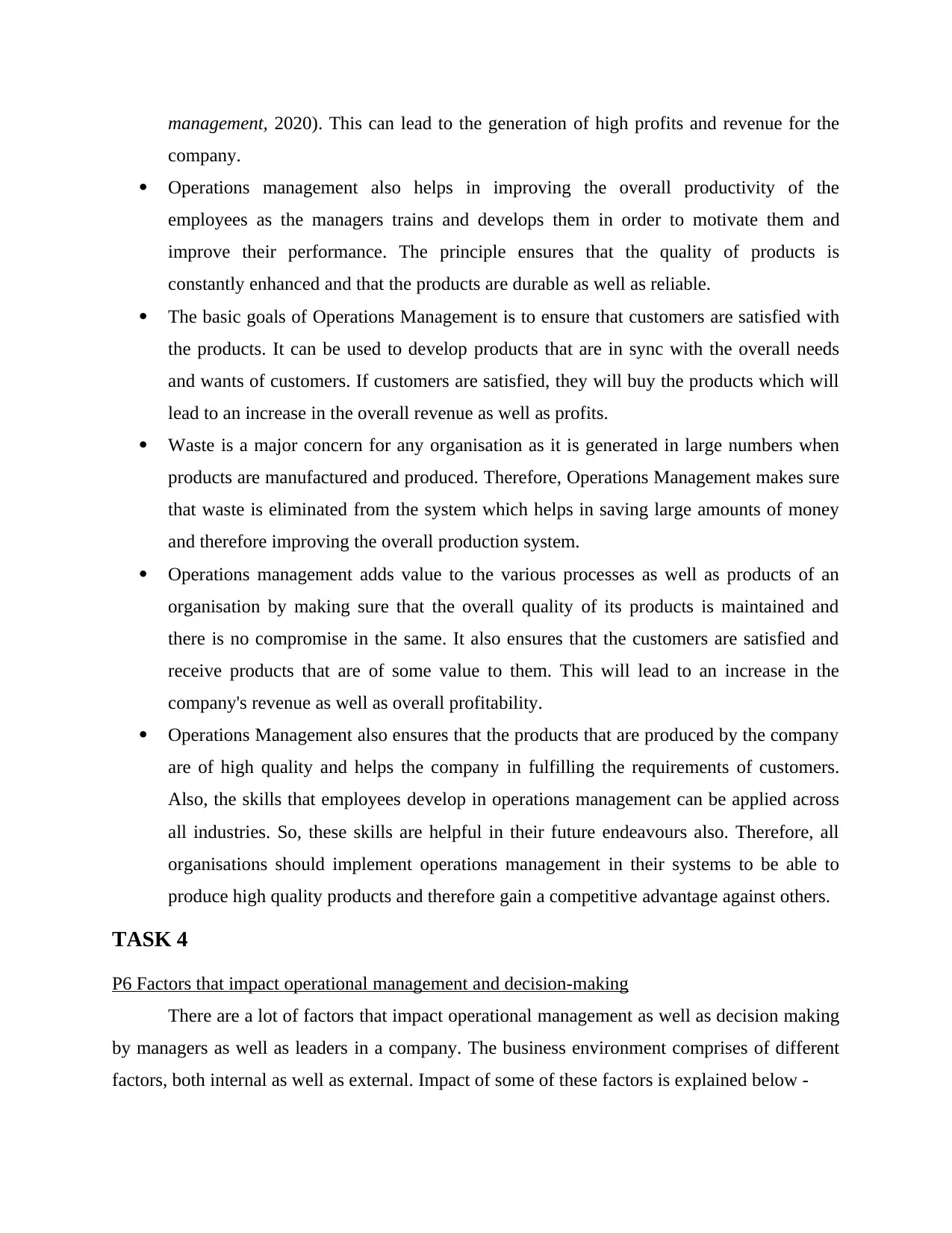
management, 2020). This can lead to the generation of high profits and revenue for the
company.
Operations management also helps in improving the overall productivity of the
employees as the managers trains and develops them in order to motivate them and
improve their performance. The principle ensures that the quality of products is
constantly enhanced and that the products are durable as well as reliable.
The basic goals of Operations Management is to ensure that customers are satisfied with
the products. It can be used to develop products that are in sync with the overall needs
and wants of customers. If customers are satisfied, they will buy the products which will
lead to an increase in the overall revenue as well as profits.
Waste is a major concern for any organisation as it is generated in large numbers when
products are manufactured and produced. Therefore, Operations Management makes sure
that waste is eliminated from the system which helps in saving large amounts of money
and therefore improving the overall production system.
Operations management adds value to the various processes as well as products of an
organisation by making sure that the overall quality of its products is maintained and
there is no compromise in the same. It also ensures that the customers are satisfied and
receive products that are of some value to them. This will lead to an increase in the
company's revenue as well as overall profitability.
Operations Management also ensures that the products that are produced by the company
are of high quality and helps the company in fulfilling the requirements of customers.
Also, the skills that employees develop in operations management can be applied across
all industries. So, these skills are helpful in their future endeavours also. Therefore, all
organisations should implement operations management in their systems to be able to
produce high quality products and therefore gain a competitive advantage against others.
TASK 4
P6 Factors that impact operational management and decision-making
There are a lot of factors that impact operational management as well as decision making
by managers as well as leaders in a company. The business environment comprises of different
factors, both internal as well as external. Impact of some of these factors is explained below -
company.
Operations management also helps in improving the overall productivity of the
employees as the managers trains and develops them in order to motivate them and
improve their performance. The principle ensures that the quality of products is
constantly enhanced and that the products are durable as well as reliable.
The basic goals of Operations Management is to ensure that customers are satisfied with
the products. It can be used to develop products that are in sync with the overall needs
and wants of customers. If customers are satisfied, they will buy the products which will
lead to an increase in the overall revenue as well as profits.
Waste is a major concern for any organisation as it is generated in large numbers when
products are manufactured and produced. Therefore, Operations Management makes sure
that waste is eliminated from the system which helps in saving large amounts of money
and therefore improving the overall production system.
Operations management adds value to the various processes as well as products of an
organisation by making sure that the overall quality of its products is maintained and
there is no compromise in the same. It also ensures that the customers are satisfied and
receive products that are of some value to them. This will lead to an increase in the
company's revenue as well as overall profitability.
Operations Management also ensures that the products that are produced by the company
are of high quality and helps the company in fulfilling the requirements of customers.
Also, the skills that employees develop in operations management can be applied across
all industries. So, these skills are helpful in their future endeavours also. Therefore, all
organisations should implement operations management in their systems to be able to
produce high quality products and therefore gain a competitive advantage against others.
TASK 4
P6 Factors that impact operational management and decision-making
There are a lot of factors that impact operational management as well as decision making
by managers as well as leaders in a company. The business environment comprises of different
factors, both internal as well as external. Impact of some of these factors is explained below -
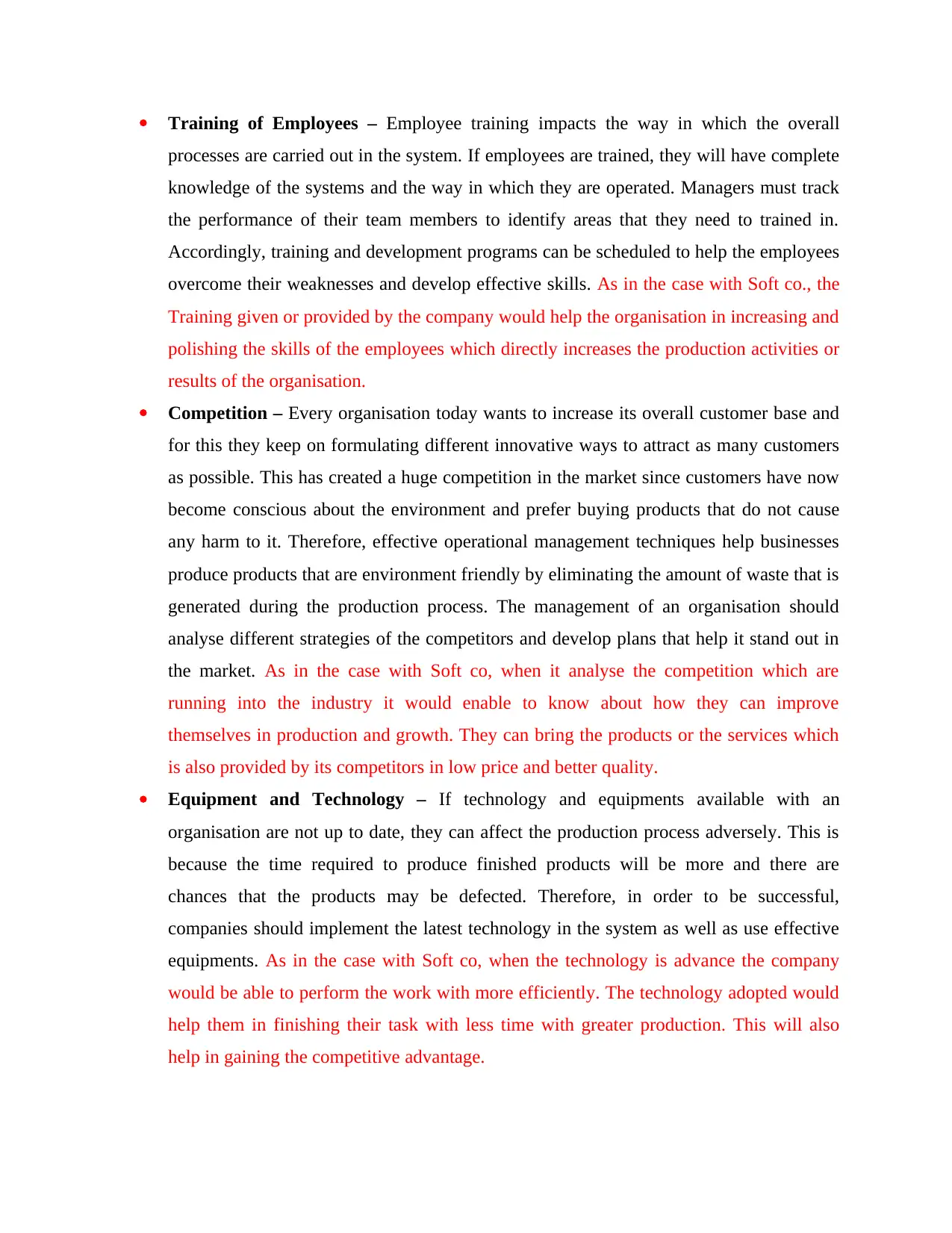
Training of Employees – Employee training impacts the way in which the overall
processes are carried out in the system. If employees are trained, they will have complete
knowledge of the systems and the way in which they are operated. Managers must track
the performance of their team members to identify areas that they need to trained in.
Accordingly, training and development programs can be scheduled to help the employees
overcome their weaknesses and develop effective skills. As in the case with Soft co., the
Training given or provided by the company would help the organisation in increasing and
polishing the skills of the employees which directly increases the production activities or
results of the organisation.
Competition – Every organisation today wants to increase its overall customer base and
for this they keep on formulating different innovative ways to attract as many customers
as possible. This has created a huge competition in the market since customers have now
become conscious about the environment and prefer buying products that do not cause
any harm to it. Therefore, effective operational management techniques help businesses
produce products that are environment friendly by eliminating the amount of waste that is
generated during the production process. The management of an organisation should
analyse different strategies of the competitors and develop plans that help it stand out in
the market. As in the case with Soft co, when it analyse the competition which are
running into the industry it would enable to know about how they can improve
themselves in production and growth. They can bring the products or the services which
is also provided by its competitors in low price and better quality.
Equipment and Technology – If technology and equipments available with an
organisation are not up to date, they can affect the production process adversely. This is
because the time required to produce finished products will be more and there are
chances that the products may be defected. Therefore, in order to be successful,
companies should implement the latest technology in the system as well as use effective
equipments. As in the case with Soft co, when the technology is advance the company
would be able to perform the work with more efficiently. The technology adopted would
help them in finishing their task with less time with greater production. This will also
help in gaining the competitive advantage.
processes are carried out in the system. If employees are trained, they will have complete
knowledge of the systems and the way in which they are operated. Managers must track
the performance of their team members to identify areas that they need to trained in.
Accordingly, training and development programs can be scheduled to help the employees
overcome their weaknesses and develop effective skills. As in the case with Soft co., the
Training given or provided by the company would help the organisation in increasing and
polishing the skills of the employees which directly increases the production activities or
results of the organisation.
Competition – Every organisation today wants to increase its overall customer base and
for this they keep on formulating different innovative ways to attract as many customers
as possible. This has created a huge competition in the market since customers have now
become conscious about the environment and prefer buying products that do not cause
any harm to it. Therefore, effective operational management techniques help businesses
produce products that are environment friendly by eliminating the amount of waste that is
generated during the production process. The management of an organisation should
analyse different strategies of the competitors and develop plans that help it stand out in
the market. As in the case with Soft co, when it analyse the competition which are
running into the industry it would enable to know about how they can improve
themselves in production and growth. They can bring the products or the services which
is also provided by its competitors in low price and better quality.
Equipment and Technology – If technology and equipments available with an
organisation are not up to date, they can affect the production process adversely. This is
because the time required to produce finished products will be more and there are
chances that the products may be defected. Therefore, in order to be successful,
companies should implement the latest technology in the system as well as use effective
equipments. As in the case with Soft co, when the technology is advance the company
would be able to perform the work with more efficiently. The technology adopted would
help them in finishing their task with less time with greater production. This will also
help in gaining the competitive advantage.
⊘ This is a preview!⊘
Do you want full access?
Subscribe today to unlock all pages.

Trusted by 1+ million students worldwide
1 out of 15
Related Documents
Your All-in-One AI-Powered Toolkit for Academic Success.
+13062052269
info@desklib.com
Available 24*7 on WhatsApp / Email
![[object Object]](/_next/static/media/star-bottom.7253800d.svg)
Unlock your academic potential
Copyright © 2020–2025 A2Z Services. All Rights Reserved. Developed and managed by ZUCOL.




